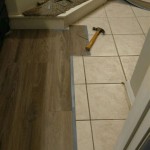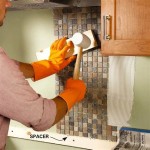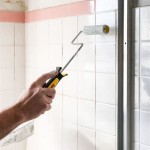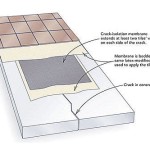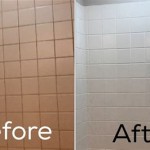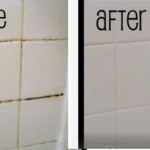What Can I Use To Get Dried Grout Off Tiles?
Dealing with dried grout on tiles is a common challenge encountered during and after tiling projects. Whether residual grout haze remains after installation or stubborn patches have hardened over time, understanding effective removal methods is crucial for achieving a clean and polished finish. This article provides a comprehensive guide to various techniques and products suitable for removing dried grout from tiles, along with considerations for tile type and grout composition.
The selection of an appropriate method for removing dried grout heavily depends on several factors, including the type of tile being cleaned (e.g., ceramic, porcelain, natural stone), the type of grout used (e.g., cementitious, epoxy), and the age and severity of the grout residue. Using the wrong approach can potentially damage the tile surface, necessitating careful assessment before proceeding.
Before commencing any cleaning process, it is advisable to test the chosen method on an inconspicuous area of the tiled surface. This precautionary step helps determine compatibility and prevents potential discoloration, etching, or other forms of damage to the tiles. Furthermore, ensuring adequate ventilation in the work area is important, especially when using chemical cleaning agents.
Vinegar Solution for Cementitious Grout
Vinegar, a readily available household item, possesses mild acidic properties that can effectively soften and dissolve cementitious grout. A solution of equal parts white vinegar and warm water is generally recommended. This mixture can be applied directly to the affected areas using a sponge, cloth, or spray bottle. Allow the solution to dwell on the dried grout for approximately 15-20 minutes to soften it. After the dwell time, scrub the area with a stiff-bristled brush, paying attention to the grout lines. Rinse thoroughly with clean water and dry with a clean cloth.
While vinegar is generally safe for ceramic and porcelain tiles, its use on natural stone tiles, such as marble or limestone, should be approached with caution. The acidity of vinegar can etch or damage the surface of certain natural stones. If using vinegar on natural stone, dilute the solution significantly and minimize the dwell time. Consider testing in a hidden area first, as mentioned above.
For particularly stubborn grout residue, the vinegar solution can be strengthened by reducing the water content. However, increasing the concentration of vinegar also increases the risk of damage, especially on acid-sensitive materials. Careful monitoring is therefore crucial.
The effectiveness of vinegar is primarily limited to cementitious grout. Epoxy grout, which is more chemically resistant, typically requires stronger cleaning agents.
Grout Haze Removers: Chemical Solutions
Commercial grout haze removers are specifically formulated to dissolve and remove grout residue from tile surfaces. These products typically contain stronger acids than vinegar, making them effective for both cementitious and epoxy grout haze. However, their increased potency also necessitates greater caution in handling and application. Always read and follow the manufacturer's instructions carefully.
Grout haze removers are available in various formulations, including acidic and alkaline options. Acidic removers, typically containing sulfamic acid or phosphoric acid, are effective for removing cementitious grout haze. Alkaline removers, on the other hand, are often preferred for epoxy grout haze, as they are better at breaking down the resinous components of the epoxy. However, the specific type of grout haze remover will depend on the grout used.
When using chemical grout haze removers, protective gear, such as gloves, eye protection, and a respirator, is essential. Apply the remover to the affected areas as directed, ensuring even coverage. Allow the solution to dwell for the specified time, then scrub with a grout brush or scrub pad. Rinse thoroughly with clean water to remove all traces of the remover. Multiple applications may be necessary for heavy grout residue.
It is crucial to select a grout haze remover that is compatible with the type of tile being cleaned. Some removers can etch or discolor certain tile surfaces. Always test in an inconspicuous area before applying the remover to the entire surface.
Mechanical Methods: Scraping and Scrubbing
For particularly stubborn or thick grout deposits, mechanical methods, such as scraping and scrubbing, may be necessary. These methods involve physically removing the grout from the tile surface using tools such as grout scrapers, scrub brushes, and abrasive pads. While effective, mechanical methods require more effort and can potentially damage the tile surface if not performed carefully.
Grout scrapers, typically featuring a sharp blade or edge, are designed to remove dried grout from grout lines and tile surfaces. When using a grout scraper, hold it at a shallow angle to the tile surface to avoid scratching. Apply gentle pressure and work in small sections. Be especially careful when scraping near corners and edges to prevent chipping or cracking the tiles.
Scrub brushes, equipped with stiff nylon or wire bristles, can be used to loosen and remove dried grout from the tile surface. When scrubbing, apply moderate pressure and work in a circular motion. For heavily soiled areas, a grout brush can be used in conjunction with a cleaning solution, such as vinegar or grout haze remover.
Abrasive pads, such as scrubbing pads or steel wool, can also be used to remove dried grout. However, these pads can scratch certain tile surfaces, particularly polished or glazed tiles. Always test in an inconspicuous area before using abrasive pads on the entire surface. Use caution with any abrasive pad and light pressure.
When employing mechanical methods, it is crucial to proceed with caution and avoid excessive force. Protect the tile surface by using appropriate tools and techniques. Regularly inspect the tile surface for any signs of damage, such as scratches or chips.
Steam Cleaning
Steam cleaning offers an environmentally friendly approach to removing dried grout, leveraging the power of high-temperature steam to loosen and dissolve grout residue. Steam cleaners utilize pressurized steam to penetrate the pores of the grout, effectively breaking down dirt, grime, and hardened deposits. This method is particularly useful for cleaning both the tile surface and the grout lines simultaneously.
When using a steam cleaner, select an appropriate nozzle attachment for the task at hand. A narrow nozzle is ideal for targeting grout lines, while a wider nozzle is suitable for cleaning larger tile surfaces. Fill the steam cleaner with distilled water, as tap water can leave mineral deposits. Allow the steam cleaner to heat up to the recommended temperature before use.
Direct the steam nozzle at the affected areas, moving it slowly and steadily along the grout lines. The high-temperature steam will penetrate the grout, loosening the dried residue. Use a grout brush or scrub pad to agitate the grout and further remove any remaining deposits. Wipe the surface with a clean cloth to remove excess moisture and debris.
Steam cleaning is generally safe for most tile types, including ceramic, porcelain, and some natural stones. However, it is essential to exercise caution when using steam on delicate or porous surfaces, such as certain types of natural stone. Excessively high temperatures or prolonged exposure to steam can potentially damage these surfaces. Always test in an inconspicuous area before applying steam to the entire surface.
Steam cleaning offers a chemical-free alternative to traditional cleaning methods, making it a suitable option for individuals with sensitivities to cleaning agents. It is an effective way to remove dried grout and sanitize tile surfaces simultaneously.
Baking Soda Paste for Mild Residue
A paste made from baking soda and water can be a gentle yet effective solution for removing light grout residue. Baking soda is a mild abrasive that can help lift the dried grout without causing significant damage to most tile surfaces. The paste is created by mixing baking soda with just enough water to form a thick, spreadable consistency.
Apply the baking soda paste directly to the areas affected by grout residue. Allow the paste to sit on the grout for approximately 10-15 minutes, giving it time to soften the residue. After the dwell time, use a soft-bristled brush or sponge to gently scrub the treated areas. Avoid using excessive force, as this could potentially scratch the tile surface.
After scrubbing, rinse the treated areas thoroughly with clean water to remove all traces of the baking soda paste. Dry the surface with a clean cloth or towel. Multiple applications may be necessary for more stubborn grout residue.
Baking soda is generally safe for use on most tile surfaces, including ceramic and porcelain. However, as with any cleaning method, it is advisable to test the paste in an inconspicuous area before applying it to the entire surface, especially on natural stone tiles. Although less acidic than vinegar, baking soda can still potentially affect certain types of stone. Be careful and test first.
The baking soda paste is most effective on mild grout residue and may not be sufficient for removing thick or heavily hardened deposits. In such cases, stronger cleaning agents or mechanical methods may be required.
Professional Grout Cleaning Services
For challenging cases involving extensive grout damage, delicate tile surfaces, or simply a desire for professional-grade results, enlisting the services of a professional grout cleaning company is advisable. These companies possess the expertise, equipment, and specialized cleaning agents necessary to effectively remove dried grout without damaging the tile surface.
Professional grout cleaning services typically employ a variety of techniques, including high-pressure steam cleaning, chemical grout removers, and mechanical scrubbing. They also have access to specialized equipment, such as rotary scrubbers and grout vacuums, which can expedite the cleaning process and achieve superior results.
Before hiring a professional grout cleaning service, it is important to research their credentials, read online reviews, and obtain references from previous clients. Ensure that the company is licensed and insured, and that they have experience working with the specific type of tile being cleaned. It’s important to communicate what type of grout needed to be removed.
Discuss the cleaning process with the company representative and inquire about the types of cleaning agents they will be using. Request a written estimate outlining the scope of work and the associated costs. It is also advisable to ask about any potential risks or precautions that may be necessary.
While professional grout cleaning services can be more expensive than do-it-yourself methods, they offer a reliable and effective solution for restoring tile surfaces to their original condition. They can be particularly beneficial for large areas or complex grout cleaning projects.

Dried On Grout Hometalk

4 Ways To Clean Grout Off Tile Wikihow

How To Get Rid Of Dried Grout On Your Stone Floor Tiles Granite Gold

4 Ways To Clean Grout Off Tile Wikihow

How To Clean Grout Tips For Natural Stone Flooring Granite Gold

How To Clean Grout Two Ingredient Diy Cleaner Lemons Lavender Laundry

Here S How Remove Mildew From Bathroom Tile Grout

Severe Grout Haze And Residue Removal From Brand New Tile How We Fix It

How To Get Rid Of Excess Grout On Outdoo Bunnings Work Community

4 Ways To Clean Grout Off Tile Wikihow
Related Posts

